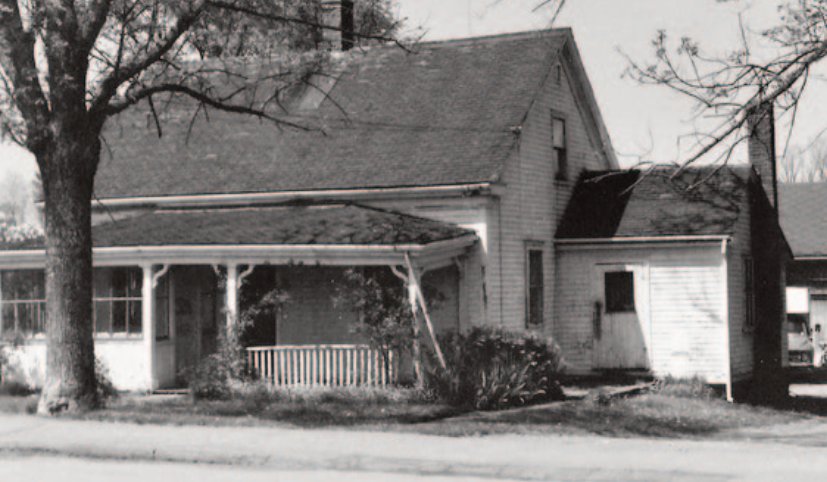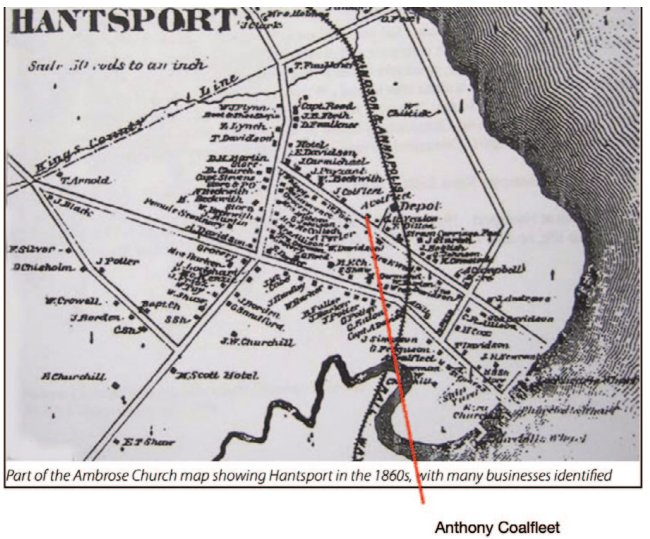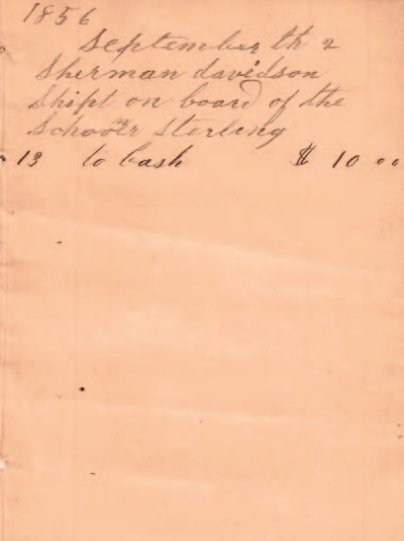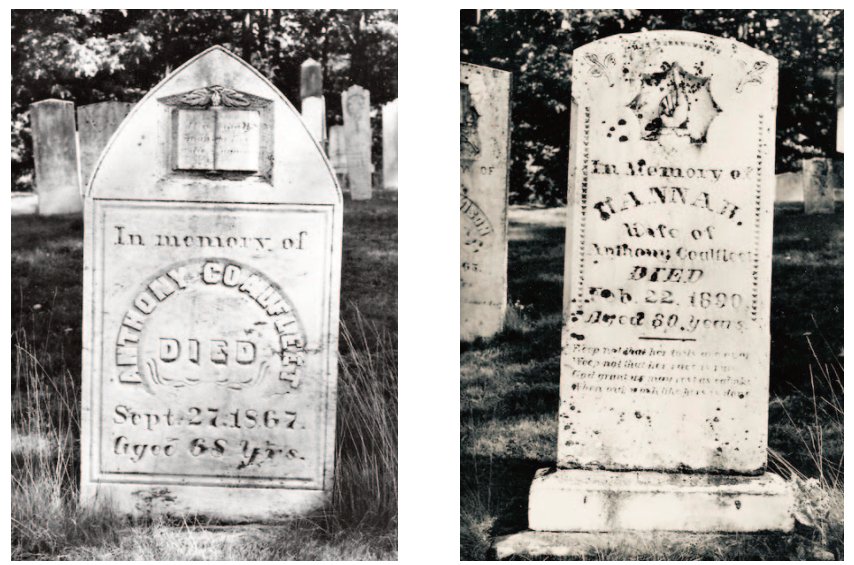
Number 27 William Street, Hantsport, has been in my family’s possession for nearly 50 years. Its history dates to before the creation of Canada (1867) when it was built c.1836 for Captain Anthony Coalfleet, his wife Hannah (nee Martin), and their young family. Many of the original features of the building remain. The family surname itself is unique to Hantsport and area.
During the early to mid-1770s, ex-soldier Edward Barker (formerly of the 2nd Battalion, 59th Regiment of Foot) had been settled in Falmouth where he had been following the livelihood of farmer. He made trips overland with cattle to sell at the Halifax market. According to oral tradition, he returned from one trip with an infant orphan boy who was the sole survivor of shipwreck carrying coal. In prosaic fashion, Barker named the child Peter Coalfleet. He would be raised with his sons and daughters in Falmouth and after the family acquired property in what became the nucleus of the village, later the town, of Hantsport. Peter Coalfleet, also a farmer by profession, built his own home across the county line in what became known as Hants Border. Here he raised a family with his wife Hannah Dorman, among whom were Anthony and Abel (both master mariners), Robert (farmer) and their daughters, Elizabeth and Lucy, who became the wives of the brothers William and Edward Davison (master mariners) of Hantsport.
William and Edward Davison’s parents Asa and Rhoda (Fox) Davison had acquired the old house at the shore end of the present-day William Street (then known as the Old Shore Road), while other sons, including William and Edward built further up the street on land purchased from their parents. Anthony Coalfleet built his house on land likewise bought from the elder Davisons, and diagonally across the street from Captain William Davison. This Coalfleet family would consist of sons Peter, Robert, and John, who built their own houses further along William Street as did Anthony’s brother-in-law, Joseph Martin. One may say that the genealogy of the houses paralleled the Davison-Coalfleet connections.

Anthony and Hannah Coalfleet’s house was in the Cape Cod tradition with some variations. The main house had its central chimney, central door flanked by one window on either side, and visible plain pilasters at the corners of the building and along the horizontal (front and back) at the roof-line. This one-and-a-half storey building has a side ell with its own chimney, which provides access to the steep (nearly 80 degree angle) staircase to the upper story. Two principal rooms open off a small hallway each with its own fireplace; the mantel surrounds are still intact though the openings have been blocked off.
The room to the right appears to have functioned as the dining room since the fireplace has a double up-and-down warming closet adjacent to it; the fireplace itself has fluted pilasters and a high mantle. Three six-panel doors remain (“Holy Cross” or “Cross and Bible” as these are sometimes called) with original hinges. One of the two upstairs bedrooms has a three-drawer dresser built into the eaves wall. On either side of the upper level there is open storage space between the exterior and interior walls in which some of the great trunnels or wooden spikes that hold the beams in place can be seen (and need to be avoided when one enters!). The foundation consists of earth excavation with sandstone blocks in place to raise the main beams above the rise of damp and rot; local sandstone quarries seem to have been the source. Several years ago, a well-worn Georgian coin was recovered from the cellar, no doubt dating from the time of construction. The current verandah and sunporch are 20th-century additions.
During kitchen renovations and insulating of the attic, my father recovered several relics of the Victorian age and a few leaves of a notebook. The latter was kept by Anthony Coalfleet with dates for 1854 to 1857. In addition, a whole child’s shoe lath and a partial lath were recovered; Coalfleet practised shoemaking on shore. The leaves of the notebook list vessels Coalfleet either commanded or served on (schooners Sterling and Sidonia, and brig William Boothby), crewmen (William Stoddard, Sherman Davison, Ingerson Card, A. Nelson, Thomas Mitchell, and Daniel Jackson);
ports of call included Windsor, Horton, and New York. The main cargo noted was the exporting of potatoes (one voyage shipped 5243 bushels to New York). Wages were also listed. I have been able to trace some of these trips by way of American newspapers [chroniclingamerica.loc.gov ] and those held by the Nova Scotia Archives (mainly the Acadian Recorder available on-line).

Anthony Coalfleet was born in the colony of Nova Scotia (c.1799) and died in the new country Canada (27 Sept. 1867); Hannah (born c.1810) outlived him until 1890. Both are buried in Hantsport Riverbank Cemetery. Anthony’s mother, the widow of Peter Coalfleet, (born c.1778) lived until her 97th year (1875) so that the oral traditions of the family were carried forward to Anthony’s children and grandchildren, and among her other descendants. Not noted in the early Women’s Institute history of Hantsport (first published 1947, edited by Hattie Chittick) or other sources was the “adventure” involving Anthony Coalfleet in 1833. Perhaps it too closely resembled piracy, though that would have been the incorrect word; nonetheless, Coalfleet was involved in an international incident that sparked a flurry of diplomatic correspondence between Fredericton, Halifax, Washington, and London.

Prior to his employment in shipping agricultural produce, Anthony Coalfleet during the 1830s was an active participant in the Hants County plaster trade (gypsum) with the state of Maine. There arose a zone of smuggling between the area that separated Maine and New Brunswick (very well described in Joshua M. Smith’s book Borderland Smuggling 2006) since captains and shipowners looked on it as a wasted trip if their ships returned to home port with empty hulls. Consequently, there were breaches of the custom regulations under the Crown authorities based in St. Andrew’s, and even in defiance of American customs officials. Coalfleet was a crew member of the schooner Wellington (possibly known in full as the Lady Wellington as given at a Windsor listing in 1830), but in 1833 he was the master in charge. William Martin was the main owner (a relation of Anthony’s wife) while John Martin was the regular captain. It was a modest vessel of 41 tons. The other ship in the Eastport and St. Andrew’s affray was the schooner Shannon (91 tons) under John Nelson of Newport, Hants County. That August 1833, there were upwards of 20 vessels from Nova Scotia at Eastport, Maine. One, the Shannon, had discharged its cargo and was sailing for Windsor when the Customs vessel’s official boarded it, discovered contraband items (including gun-powder), and ordered Nelson to sail into St. Andrew’s for holding where the cargo was to be confiscated. The incident occurred off Indian Island, and was visible to the ship crews and residents of Eastport.
On August 9, a group of armed men led by Anthony Coalfleet in the Wellington sailed into St. Andrew’s during the day, expelled the Customs men from the Shannon, liberated Nelson and his vessel, and returned in triumph to Eastport amid on-shore celebratory greetings. Thereafter, the two vessels


sailed back to Nova Scotia. A flurry of correspondence arose in the ensuing months between the Provincial Secretaries of New Brunswick and Nova Scotia, and respective ambassadors for the United States and Britain. Rather different versions of the “facts” were noted — either a party of over 50 men were involved, or only a handful; full collusion of Eastport residents in the affray or only a handful; worthies of Eastport averred that it was a small matter, while a British consular agent there had an opposing view. It seems that the incident was allowed to fade away to avoid any risk of diplomatic ruptures. Nonetheless, the documentation did offer names, places, and insight into the plaster trade.
Three years later Anthony Coalfleet moved across the county line from Kings to Hants where he built his house on William Street. With a growing family, he led a more conventional life, though one can hardly imagine that his 1833 adventure was not repeated to his children for entertainment. The house has its stories in its occupants — Coalfleet the Master Mariner; a later owner who was a sailmaker in the shipyards of Hantsport; one of the community’s early coal merchants; and the mill worker who inspired a two-mile road race to encourage the young in that sport. The double genealogy of people and buildings along William Street remind us of the value in searching out history.
Appendix:
brigantine William Boothby: 109 tons: built St. Martin’s, NB, 1844: Original owners: James Cochrane, Windsor, NS, mariner and shares held by St. Martin’s men; 1847 Cochrane sold his shares to Ebenezer Smith, Falmouth, NS, mariner, and Albert Smith, Falmouth, NS, mariner. Owner 1857: Leonard Martin, Falmouth, NS, mariner [Brother-in-law to Anthony Coalfleet]; 1860 ownership transferred to Saint John, NB, registry
schooner Shannon: 91 tons: built 1829 at Petite, Hants Co., NS: owner 1830 was D. Sanford; master in August 1833 John Nelson of Newport, NS
schooner Sidonia: 74 tons: built Parrsboro 1849: Registry of Shipping noted that “Not heard from for many years. Registry closed May 28, 1874”
schooner Sterling: 78 tons: owners Peleg Holmes Sr. master, Kendall Holmes, mariner: built Cornwallis 1845; builder Daniel Huntley; still listed in 1857
schooner Wellington: 41 tons: owner 1830 William Martin; master August 1833 Anthony Coalfleet; master 1834 John Martin
Bibliography:
Coalfleet, Anthony. Notebook: 1854-1857. Unpublished Manuscript.
Manning, Walter K., ed. Diplomatic Correspondence of the United States: Canadian Relations: 1784-1860. Washington,
DC: Carnegie Endowment for International Peace, 1947
National Archives and Library Canada {bac-lac.gc.ca]: Register of Shipping.
Nova Scotia Archives:
– RG1 Vol. 14: 1833 Dec. 30: re: Anthony “Coldfleet”
– RG7 [Provincial Secretary’s Papers]: 1833 #69 and #71 re: Anthony “Coldfleet”
– RG36 [Court of Chancery]: #1113: Crane vs Martin [Heirs of]
Paulin, Charles Oscar and Frederic L. Paxson, Guide to the Materials in London Archives for the History of the United States since 1783 (Washington, DC: Carnegie Institution of Washington, Publication no. 90B, 1914)
Robertson, Allen B. Tide & Timber: Hantsport, Nova Scotia 1795-1995. Hantsport, NS: Lancelot Press, 1996; repub. Milton, ON: Heritage Press, 2001.
Smith, Joshua M. Borderland Smuggling: Patriots, Loyalists, and Illicit Trade in the Northeast 1783-1820. University Press of Florida, 2006.
Acknowledgement:
The Hantsport & Area Historical Society would like to thank the author for kind permission to reprint this article. It first appeared in The Nova Scotia Genealogist Vol. XXXX/1, (Spring 2022) published by The Genealogical Association of Nova Scotia.
